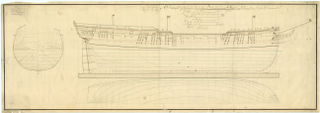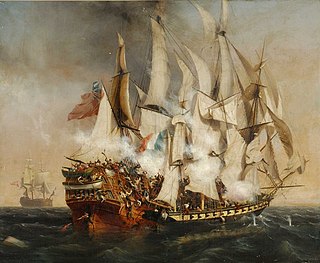
HMS Thetis was a 38-gun fifth-rate frigate of the Royal Navy launched in 1782.

HMS Cerberus was a 32-gun fifth-rate frigate of the Royal Navy. She served in the French Revolutionary and the Napoleonic Wars in the Channel, the Mediterranean, the Adriatic, and even briefly in the Baltic against the Russians. She participated in one boat action that won for her crew a clasp to the Naval General Service Medal (NGSM). She also captured many privateers and merchant vessels. Her biggest battle was the Battle of Lissa, which won for her crew another clasp to the NGSM. She was sold in 1814.

HMS Forester was a Royal Navy 18-gun Cruizer-class brig-sloop built by John King and launched in 1806 at Dover. She had a relatively uneventful career before the Navy sold her in 1819.
HMS Amaranthe was an 18-gun Royal Navy Cruizer-class brig-sloop built by John Dudman at Deptford Wharf and launched in 1804. She served in the Caribbean, taking part in an action and two campaigns that gained those members of her crew that survived until 1847 the NGSM. She was sold in 1815.
HMS Circe was a Royal Navy 32-gun fifth-rate frigate, built by Master Shipwright Joseph Tucker at Plymouth Dockyard, and launched in 1804. She served in the Caribbean during the Napoleonic Wars, and participated in an action and a campaign for which in 1847 in the Admiralty authorised the issuance of the Naval General Service Medal with clasps. The action, off the Pearl Rock, near Saint-Pierre, Martinique, was a debacle that cost Circe dearly. However, she also had some success in capturing privateers and a French brig. She was sold in 1814.

HMS Belette was an 18-gun Cruizer-class brig-sloop, built by King at Dover and launched on 21 March 1806. During the Napoleonic Wars she served with some success in the Baltic and the Caribbean. Belette was lost in the Kattegat in 1812 when she hit a rock off Læsø.
HMS Eclair was a French Navy schooner launched in 1799 and captured in 1801. The British took her into service under her French name and armed her with twelve 12-pounder carronades. In 1804 she engaged in a noteworthy, albeit indecisive single ship action with the 22-gun French privateer Grande Decide. In 1809 she was renamed Pickle. In December 1812 she and three other small British vessels engaged the French 40-gun frigate Gloire in another noteworthy and indecisive action. She was sold in 1818.

HMS Redwing was a Cruizer-class brig-sloop of the British Royal Navy. Commissioned in 1806, she saw active service in the Napoleonic Wars, mostly in the Mediterranean, and afterwards served off the West Coast of Africa, acting to suppress the slave trade. She was lost at sea in 1827.

HMS Superieure was the French privateer Supérieure, which was built in 1801 in Baltimore, Maryland, and which the British captured in 1803 in the West Indies, and took into the Royal Navy. She spent most of her career on the Jamaica and Leeward Islands stations, where she captured numerous privateers. She participated in several notable single-ship actions, including one in which she harassed a frigate, and two campaigns that would, in 1847, earn her surviving crew members the Naval General Service Medal (NGSM). She was laid-up in Britain in 1810 and sold in 1814.
HMS Port d'Espagne was a 14-gun vessel, variously described as a sloop, gun-brig or schooner, built in 1806 in Trinidad, whose citizens presented her to the crown. She captured several small Spanish privateers and participated in a major campaign before she was sold in 1811.
HMS Express was the name-ship of a class of two schooner-rigged advice-boats of the Royal Navy. Express was launched in 1800 and served until she was sold in 1813. During her career she served in one action and one campaign that in 1847 qualified her surviving crew members for clasps to the Naval General Service Medal.
HMS Subtle was a schooner that the Royal Navy reportedly captured in 1807, and purchased and registered in 1808. She served in the Caribbean, taking part in several actions, including a small debacle in 1808, and the capture of Martinique and Guadeloupe in 1809. She foundered in November 1812 with the loss of her entire crew.
HMS Redbreast was an Archer-class brig of the British Royal Navy. She captured some small merchant vessels and privateers. She also participated in two actions that would in 1847 earn her surviving crew members clasps to the Naval General service Medal (NGSM). The Navy transferred in 1816 to His Majesty's Customs. She was finally sold in 1850.
The French brig Nisus was a Palinure-class brig of the French Navy, launched in 1805. The Royal Navy captured Nisus at Guadeloupe in 1809. The British took her into service as HMS Guadaloupe, and sold her in November 1814.
HMS Pultusk was the American-built French privateer sloop Austerlitz, which had been launched in 1805 and which the Royal Navy captured in 1807 and took into service as HMS Pultusk. Pultusk served in three campaigns, two of which resulted, some four decades later, in the award of medals, and one boat action that too received a medal. She was broken up in 1810.

Confiance, launched in 1797, was a privateer corvette from Bordeaux, famous for being Robert Surcouf's ship during the capture of the British East India Company's East Indiaman Kent. Confiance had captured a number of ships through the years before the British Royal Navy captured her in 1805, taking her into service under her existing name. The Royal Navy sold her in 1810, by which time she had taken part in two notable actions in British service. Confiance then sailed as a merchantman, until 1816.
HMS Elizabeth was a French privateer schooner that the Royal Navy captured in 1805 and took into service under her existing name. She participated in an engagement and a campaign that earned her crews clasps to the Naval General Service Medal. She was lost with all hands in 1814 when she capsized in the West Indies.
HMS Bacchus was a Dutch 10-gun schooner launched c.1806 that the British Royal Navy captured in 1807 and took into service in 1808 under her existing name. She served in several campaigns that earned her crews clasps to the Naval General Service Medal. She was broken up in 1812.
HMS Morne Fortunee was the French privateer Regulus that British Royal Navy captured in 1804. In 1806 the Royal Navy commissioned her. She captured some small privateers and took part in a number of other engagements. She foundered in 1809.
HMS Conflict was launched in 1805. She captured a number of vessels, including privateers, and participated in several major actions. She disappeared in November 1810 with the loss of all her crew.




